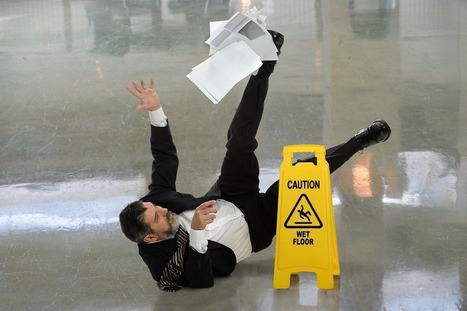With its fast-paced nature and hands-on approach, workers in the hospitality sector are no strangers to the occasional bump or bruise. These aren’t usually anything to worry about, unless the cause was an entirely preventable risk. That certainly isn’t something employees should ignore.
Such injuries totalled 434,000 cases between 2016/17 that needed up to seven days’ recovery time as absence. Beyond this, 175,000 cases required more than seven days. It is true that the hospitality sector has a lower than average amount of work-related illness cases, but it does have a higher than average work accident level.
In this article, we are investigating the most common injury causes in the hospitality sector as outlined by Boutique Hotelier’s study, and offering up methods of prevention and response.
1. Slips, trips and falls
The most common cause of injury in the hospitality sector comes under the category of slips, trips and falls. Accidents of this nature are the most common among non-fatal injuries to employees, accounting for 29% of the most common non-fatal accident kinds. It’s hardly surprising, given the nature of such accidents — nearly every workplace has the capacity to develop a slip or trip hazard! A spilled drink in the office, a curled rug corner in a shop, or something bigger like an oil or chemical spill in a factory. These things happen, but the problem arises when the spills and trip hazards aren’t addresses immediately, turning the risk into a cause. This is when an accident becomes a work accident, as a failure to follow or implement a process (i.e. the workplace is at fault for not having a necessary routine to address the spill or trip hazard before an accident materialised).
Ways to prevent injury:
Methods of prevention include:
- Non-slip footwear
- Signs to signal any recent spills
- Adequate lighting
- A process in place that has spills tended to immediately
- Signs for slippery areas
- Danger tape to highlight any potential trip hazards, such as steps or uneven flooring
Response to a fall:
Take your time in getting up after a slip, trip or fall. Only do so if you feel strong enough to.
2. Lifting/handling
Injuries caused by lifting and handling items are the second most common within the sector. These injuries account for 22% of all non-fatal injuries in hospitality. Injuries from lifting and handling heavy items tend to revolve around muscle strains. Back pain, neck pain, arm pain, and leg pain can all result of a lifting or handling injury. These injuries usually occur over a stretch of time where you are frequently handling heavy goods, but it is possible to injure yourself from a one-off heavy item lifting situation. Your workplace ought to provide training for handling heavy goods, as well as relevant lifting apparatus where needed.
Ways to prevent injury:
Prevention methods include:
- Using apparatus to help lifting, where available
- If you think lifting equipment should be in place for a task, speak to your employer. Employees are often the best eyes and ears for potential risks!
- Training on how to lift heavy goods
- Ask for help with lifting heavy items
Response to a strain:
Apply an ice pack for 20 minutes every two or three hours. A compression bandage can help to support the injury too, and elevating the affected area is advised. Avoid heat, as this can aggravate swelling.
3. Struck by an object
The third most common cause of hospitality injuries is being struck by an object (10%). Such injuries can cause a varying degree of problems, from minor cuts and bruises to more serious results like concussion or even blindness. Items falling from a high shelf, moving loads with machinery, and dropping tools are all common causes of these accidents.
Ways to prevent injury:
Prevention methods will vary depending on the workplace, but generally:
- Avoid working or moving under a moving load
- Make sure that any objects that aren’t on ground level are secure
- Following from this, be sure that these items won’t be easily knocked
- Heavier items should be stored near the ground, and lighter items higher up.
- Self-standing items should be secured or stabled
- When using machinery to move loads, such as when operating a pallet truck or trolley, stick to designated routes
- Inspect lifting apparatus to ensure everything is working
Response to being struck by an object:
If the wound is bleeding, the first step is to stop the bleeding. Applying pressure with a clean, absorbent material will help with this. For more severe bleeding, raise the afflicted area: your arm or hand can be raised over your head, where lower limbs you should lie down and raise the limb above your heart. Clean the wound, cover it and seek medical help if the wound becomes infected.
Suspected concussion requires the injured party to head straight to accident and emergency. Signs of concussion include a persistent headache, dizziness, confusion and/or memory loss, vomiting or sickness, imbalance, mood swings, vision changes, and struggling to stay awake.
4. Fall from height
Falling from any height other than floor level accounts for 7% of injuries. Although falling from a height is the fourth most common non-fatal work accident, they are the third highest contributor to fatal injuries at 20%. Injuries from these sorts of accidents include broken limbs, fractures, bruises, concussion, and more.
Within this category, certain locations caused more falls than others. The most common places to fall from where ladders (40%), vehicles (17%), machinery (10%), platforms (10%), stairs (8%), roof (7%), scaffold (4%), warehouse racking (4%).
Ways to prevent injury:
- Minimise the risk of falling from a ladder climbing slowly, and avoid sudden movements
- Ensure the type of ladder or scaffolding is correct for the job at hand
- Where possible, control points and work should be designed to take place on ground level where possible
- Permanent safety features should be installed if working at a height is frequent
- Steps, railing, etc.
- Do not overreach when on a ladder or scaffolding
Response to falling from a height:
The injure sustained by a fall from a height can vary. Depending on the severity of the injury, medical attention will likely be required for a fall from a height.
5. Acts of violence
7% of non-fatal work accidents in the hospitality sector are caused by acts of violence. Unlike with the other accident causes in this article, it’s difficult to narrow down the resulting injury from this cause of workplace accident. Generally, employees who deal with face-to-face roles are at risk of violence, from customers or even other employees. The injury caused by acts of violence can vary wildly, but that doesn’t mean they cannot be prevented.
Ways to prevent injury:
- Physical security measures, such as CCTV and security locks
- Wider counters can help protect staff in customer-facing roles
- Regular staff meetings can be effective in highlighting problems faced day-to-day at work
- Informing your employer is a strong first step to having the matter addressed
- Detailed records of previous incidents will help to identify patterns, causes, and areas of concern
We can’t prevent all accidents. But the workplace ought to have measures in place to reduce the risk as much as feasible possible to protect its employees, as well as reduce the number of work accident claims the company needs to address. There has been a downward trend in self-reported workplace non-fatal injuries in the lead up to 2010/11, but it hasn’t risen or dropped significantly in recent years. With the right prevention methods, these common workplace accidents can hopefully be prevented enough to see another decrease soon.


